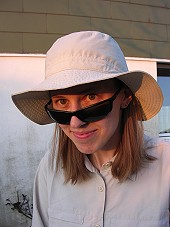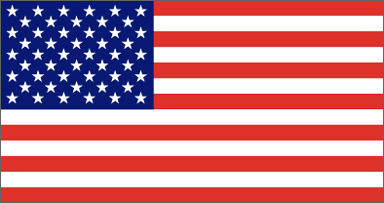
MARTINA'S WORLD TRIP
UNITED STATES: September 26 - December 3, 2004


(Übersetzungshilfe)
 |
MARTINA'S WORLD TRIP UNITED STATES: September 26 - December 3, 2004 |
|||||||
 |
||||||||
 |
Your Dictionary
(Übersetzungshilfe) |
|||||||
| Sunday, October 10th, 2004 - New Orleans, Louisiana | |||||||
| We slept long today and only got into town around noon. We had planned to go on a bus tour today to explore a little more of New Orleans. The tour started at 2:30 and took about 90 minutes. We first did a part of the French quarter, passing by St. Louis Cathedral and Jackson Square, which was used as a drill field for the French militia in 1721 and nowadays is filled with an assortment of street musicians, artists and fortune-tellers. St. Louis Cathedral is the oldest continuously active Roman Catholic Cathedral in the United States and was rebuilt in 1794, after a hurricane and a fire had destroyed previous versions in 1722 and 1788. We also passed the Ursuline Convent. In 1728, 12 Ursuline nuns arrived in New Orleans to care for the French garrison’s hospital and to educate the young girls of the colony. Between 1745 and 1752, the French colonial army built the convent, now the oldest structure in the French Quarter and actually in the whole Mississippi River Valley. The bus continued its way to Faubourg Marigny, another quarter of New Orleans famous for being one of America’s oldest black neighbourhoods. The bus driver, who was at the same time our tour guide, told us a lot about local architecture – e.g. I learned what a ‘shotgun house’ is and why some of them have ‘camelbacks’... Halfway through the city tour, we could get off the bus for a short walk around St. Louis Cemetery #3, one of New Orleans’ famous cemeteries. They are also known as “Cities of the Dead” because in New Orleans, the dead are buried in above ground tombs. These stone-built monuments are tributes to the city’s ancestors, some dating back to the 18th and 19th centuries. Nowadays, residents of New Orleans continue the tradition and we’ve heard two different explanations for this unusual custom: One reason might be the very high water table of the city, which precludes burying underground. On another tour, however, we were told that the above ground burials took already place before the people even knew about water tables. Therefore, another explanation could be that the people simply intended to honour and continue their European heritage, since above ground burials were common practice in Spain at that time. Both explanations seem reasonable but either way, it is worth visiting a New Orleans cemetery for its family tombs, ‘oven vaults’ and very special atmosphere. After the cemetery experience we continued our tour and the bus followed the path of the St. Charles Avenue streetcar. This was the tramway we always took to the city centre but this time we followed the route in the other direction towards the very exclusive Garden District. Following the Louisiana Purchase in 1803, subdivision of former plantation lands began in the Lower Garden District and extended uptown. Many elegant mansions line the streets and boulevards, surrounded by oaks and palm trees, lawns and lush, fragrant floral gardens. I’ve read that many of the oak trees actually date back to before the Civil War! They have survived hurricanes, droughts, insects and fires for more than 150 years... The houses in this area were fantastic, I almost felt like on a set of “North and South” (Fackeln im Sturm). So beautiful and stunning, I loved it. Although it was raining cats and dogs when we started the city tour, the sky finally cleared off when the tour was over – and we couldn’t have asked for a better timing. We set off towards the French Quarter again where we wanted to have a closer look at some of the sights the driver had mentioned during our bus tour. We also decided to visit a Voodoo Museum in order to learn more about this exotic form of spiritual expression first brought to New Orleans by West African slaves who came on ships via Haiti. The museum turned out to be a tiny store with two rooms in the back, crammed with all sorts of voodoo utensils, old photographs, wooden masks, offering altars, animal skeletons or their skins preserved in jars. The “highlight” used to be an albino boa named ‘Jolie Blonde’ kept in a terrarium. Unfortunately, she had deceased some time earlier this year, so only a sign “In loving memory...” remained. All this was part of a private collection exposed here for interested visitors. Overall it was an interesting place, although with a slightly weird atmosphere. Aaron didn’t like it, as it “scared the piss” out of him. Well, it didn’t scare me because I am interested in the whole energy aspect of voodoo but it’s true that the “museum” did not offer much background information about the items exposed. For example, a strange looking piece of wood was labelled as a ‘satanic tripod from the 13th century’ – without any further explanation what a ‘tripod’ even is, not to speak of its purpose or origin. Also, the altars were loaded with “offerings” like money, cigarettes, flasks of alcohol, and various hygienic products, while signboards “encouraged” the visitor to offer whatever he deemed appropriate in order to please a certain spirit and make sure his voodoo curse wouldn’t hit him... yeah, very strange. Plus the shop at the entrance with its very commercial “voodoo articles” didn’t help much to take the whole thing serious. But hey, I still learned something about voodoo as a religion, e.g. that it incorporates quite a few aspects of Catholicism – did you know that? After the visit at the Voodoo Museum, we returned to Bourbon Street for some shopping. I wanted to buy postcards and beads. Beads are these famous necklaces made of shiny plastic pearls. Usually people wear them for Mardi Gras (= Carnival Season in New Orleans when people go crazy) but on Bourbon Street, Mardi Gras is every day. Aaron also wanted to buy something: he really likes spicy dishes and was looking for a hot sauce as the ones typically used in local cooking. You should know that New Orleans has a very well-deserved reputation for food. There are more than 3000 restaurants in the city, many of which have been owned and operated by the same families for generations. The predominant foods are Creole and Cajun, but there are many ethnic restaurants that feature food from throughout the world. And as most of you are probably not familiar with the terms ‘Creole’ and ‘Cajun’ – which you encounter everywhere in New Orleans – here’s another little lesson: What is Creole? No one seems to be able to agree on a single definition of the word Creole. There are as many as 30 different definitions, probably because the word has been modified over the centuries, taking on new meanings as Louisiana’s blend of cultures evolved. One thing, however, is certain: Creoles have had a major influence on New Orleans’ architecture and cuisine. One definition of Creole is a descendant of an early French or Spanish settler, born in the colony. But Creole can also mean a mixture of African and French or Spanish settlers, born in the colony. Generally, Creole refers to the first generation of settlers born in Louisiana who are from European origin. Today, people who identify themselves as Creole live in many parts of Louisiana, including Cajun Country and the New Orleans area. What is Cajun? The 700,000 Cajuns who live in South Louisiana are descendants of French Canadians. They came from Brittany, Poitou, Normandy and from across France to establish the French Colony Acadia, now Nova Scotia, Canada. That was in 1604, 16 years before the famous Mayflower landed at Plymouth Rock. For refusing to pledge allegiance to the British crown and the Anglican church when Acadia was acquired by Great Britain, these early settlers were forced from their homes in 1755 and moved south in search of new homeland. Eventually, many settled in South Louisiana. For several generations, the Cajuns raised crops and lived on the bayou where they fished and trapped. Today, Cajuns are famous for their unique French dialect (a patois of 18th century French), their music, their spicy cooking, and for their ability to live life to its fullest. They continue to preserve their folk customs. In the end, Aaron bought a sauce called – and I’m not kidding – “Fucking Hot Sauce”, which perfectly keeps its promise... Later we had an early dinner in the backyard of a very nice restaurant. This restaurant was also the meeting point for our next activity: a guided walking tour entitled “Ghost & Vampire Tour – Experience an eerie evening walk of suspense into the dark edges of the haunted historic French Quarter”. Before coming here, I had no idea that New Orleans was also called “The Most Haunted City of America” and obviously, I was more than interested to know why. So we decided to join this tour and find out. The tour started at 8:30 pm, leading a group of courageous tourists into the dark secrets of New Orleans. Our tour guide was a woman in her 50s, completely dressed in white and with short, hydrogen-blonde hair. She wore dangling earrings in the shape of black Halloween bats and a hair-band that had white plush “ears” in spider web design. Her name was Liz and she was, in spite of her outfit, a very good guide. For two hours, we followed her through the alleys of the French Quarter and listened to her spook stories. The tour was organised in such a way that we would stop in front of buildings that were reportedly haunted and Liz told us about the spirits that did not yet fully leave our world. Each ghost had his or her very special story and the circumstances leading to their death were mostly tragic, sometimes romantic and in some cases brutal. Although we didn’t see any apparition, I have no problem believing some of the stories and just imagining the ghosts gave me the creeps... Again, we went to bed late but already now I knew I love this city. |
|||||||